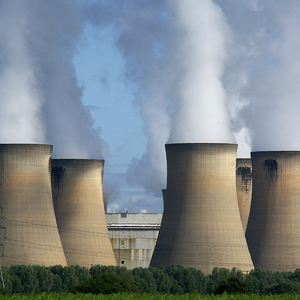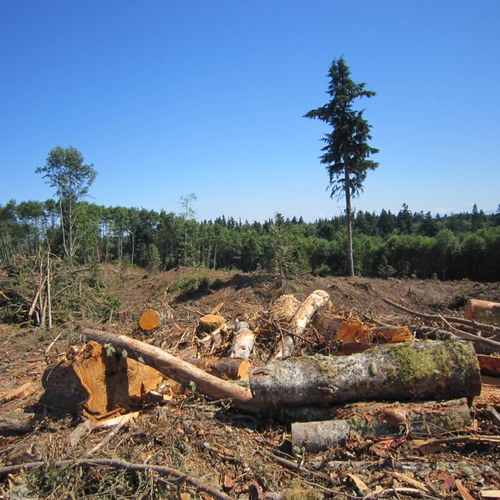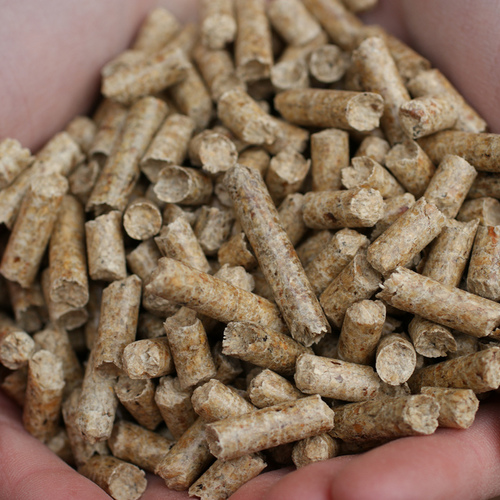
Image Credit: Naim Jennings via Flickr
This post originally appeared at Yale Environment 360.
It was once one of Europe’s largest coal-burning power stations. Now, after replacing coal in its boilers with wood pellets shipped from the U.S. South, the Drax Power Station in Britain claims to be the largest carbon-saving project in Europe. About 23 million tons of carbon dioxide goes up its stacks each year. But because new trees will be planted in the cut forests, the company says the Drax plant is carbon-neutral.
There is one problem: Ecologists say that the claims of carbon neutrality, which are accepted by the European Union and the British government, do not stand up to scrutiny. The forests of North Carolina, Louisiana, and Mississippi — as well as those in Europe — are being destroyed to sustain a European fantasy about renewable energy. And with many power plants in Europe and elsewhere starting to replace coal with wood, the question of who is right is becoming ever more important.
Since 2009, the 28 nations of the European Union have embarked on a dramatic switch to generating power from renewable energy. While most of the good-news headlines have been about the rise of wind and solar, much of the new “green” power has actually come from burning wood in converted coal power stations.
Wood burning is booming from Britain to Romania. Much of the timber is sourced locally, which is raising serious concerns among European environmentalists about whether every tree cut down for burning is truly replaced by a new one. But Drax’s giant wood-burning boilers are fueled almost entirely by 6.5 million tons of wood pellets shipped annually across the Atlantic.
In September, some 200 scientists wrote to the EU insisting that “bioenergy [from forest biomass] is not carbon-neutral” and calling for tighter rules to protect forests and their carbon. Yet just a month later, EU ministers rubber-stamped the existing carbon accounting rules, reaffirming that the burning of wood pellets is renewable energy.
Carbon stocks are under-reported
Under the terms of both the UN Paris climate agreement and Europe’s internal rules, carbon losses from forests supplying power stations should be declared as changes to the carbon storage capacity of forest landscapes. But such changes are seldom reported in national inventories. And there is no system either within the EU or at the UN for reporting actual changes in carbon stocks on land, so the carbon is not accounted for at either end — when trees are cut, or when the wood is burned.
Wood burning is turning into a major loophole in controlling carbon emissions. The U.S. could be the next country to take advantage. A federal spending bill that passed the House of Representatives last year directed the Environmental Protection Agency to establish policies “that reflect the carbon neutrality of biomass” and to “encourage private investment throughout the forest biomass supply chain,” paving the way for a boom in American pellet burning.
I have tracked these developments for the past two years; first traveling with Drax to see its U.S. pellet operation, and then investigating the criticisms leveled by European and U.S. forest campaigners. The debate is not clear-cut. Burning wood may be close to carbon neutral in some situations, such as where it is clear that cut trees are replaced with the same trees, one for one; but in others it can emit even more carbon than coal. The trouble is that regulators are ill-placed to tell the difference, which will only be clear decades after the presumed emissions have been tallied — or not — in national carbon inventories.
The one certainty is that if things do not go according to plan, Europe’s promises for meeting its Paris climate commitments will go up in smoke. And the U.S.’s own CO2 emissions could resume their upward path even quicker than President Donald Trump intends.
Cutting on a grand scale
Europe’s forests have for centuries been cut for household fuel and, in the past century, for local heating plants. But what is happening now is on a very different scale. The change has been fueled by new technology that converts timber into wood pellets that have been heated to remove moisture and compressed, which makes long-distance transportation practical and economic.
Roughly half the cut wood in the EU is now being burned to generate electricity or for heating. And there is growing evidence that the logging is damaging forests and reducing their ability to store carbon.
One region at risk is the Carpathian Mountains, stretching from Austria to Romania. It contains the continent’s largest surviving old-growth forests outside Russia, which are home to up to half the continent’s brown bears, wolves, and lynx.
.preview.jpg)
In Romania, Greenpeace and the Environmental Investigation Agency (EIA) have reported widespread illegal logging, with much of the timber exported for burning in power stations in Austria and Germany. The EIA has accused Schweighofer, a company owned by one of Austria’s richest families, of processing illegally harvested wood from Romania. Its investigator Susanne Breitkopf told me there is “a clear link between illegal logging in Romania and the EU wood pellet market.” The company says it “makes all possible efforts” to keep illegal timber out of its supply chain.
A troubling visit to Slovakia
On a visit to the region, I saw strong evidence of a threat to forests in eastern Slovakia, where there was widespread felling of beech forests inside the Poloniny National Park. The roads to the park were all being widened, using EU infrastructure funds, to improve access for heavy vehicles that bring out the timber.
My guide was Peter Sabo of Wolf, an NGO campaigning to protect the country’s forests. He estimates from Slovakian government data that 10 million cubic meters of wood is logged in the country each year, against a sustainable yield of 6 million cubic meters. The difference is almost entirely accounted for by the 3.5 million cubic metres burned for Slovakia’s energy and heating. Yet nowhere do the carbon emissions from this burning turn up in the carbon accounts of Slovakia or the EU.
Sabo and I tracked logs from Poloniny to a power station in the medieval town of Bardejov. The station’s owners insist that, like Drax, the plant only burns low-grade timber that would otherwise go to waste. But on the day I visited, the yard adjacent to the power plant was full of logs a meter or more in diameter being chipped and placed on a large pile within meters of the station’s boilers. Later, in an email, the company’s manager, Stanislav Legat, insisted that “we only use chips. Logs whom you see on the courtyard is not ours [sic].”
Forest cover in Europe is increasing, and the forests are acting as a growing carbon “sink.” But an EU report last year forecast that the growth of Europe’s forest sink will be reduced by more than 30% between 2005 and 2030 because of cutting for pellet burning and other changes in land use. It said that “biomass and land use change can be identified as key drivers” in the predicted decline, with pellet-burning plants clearly playing a large part. Yet so far, the resulting releases of carbon to the atmosphere are not included in EU carbon accounting.
Foreign forests have also been targeted to fuel European power stations. For several years, the Swedish state power company Vattenfall imported wood chips from old rubber trees on the giant Firestone rubber plantation in Liberia. The project, part-funded by the Overseas Private Investment Corporation, a U.S. federal agency, had originally promised to light homes in the West African nation. But that never happened, and after the project collapsed in 2012, the wood chips began being shipped to Sweden.
U.S. is now Europe’s biggest foreign supplier
Drax buys on a small scale from Canada and has plans to buy Brazilian wood. But the U.S. has become Europe’s biggest foreign supplier, and Drax has become the test case for whether wood pellets can be a genuine low-carbon energy source. So how does the case stack up?
Following conversion of its boilers, two-thirds of the power from the 4,000-megawatt power giant on the east coast of England now comes from burning pellets. The pellets mostly come from three American mills run by the Drax Group — at Amite in Mississippi, and Morehouse and LaSalle in Louisiana — and purchases from other U.S. suppliers, notably Enviva, which has in the process become the world’s largest producer of wood pellets.
Drax says the only carbon footprint from burning those pellets is from the harvesting, processing, and transporting of the wood. It reckons that, overall, converting its power plant from coal to wood saves 12 million tons of CO2 emissions a year, making Drax “the largest carbon-saving project in Europe,” according to its CEO Andy Koss.
The EU and the U.K. both accept that analysis. The British government last year gave the company the equivalent of about $720 million in subsidies to make further conversions to burning wood so as to reduce the country’s carbon emissions in line with the 2015 Paris climate agreement.
But critics say there are a series of problems with the claim. The first is that nobody can be certain the new trees necessary to absorb power-station emissions will ever be planted, especially since Drax does not own the forests harvested for its timber. A British government study in 2014 concluded that a worst-case scenario, in which the logged forest land is turned over to agriculture, could result in total CO2 emissions twice as great as from burning coal.
Drax and its allies say this is most unlikely. Dale Greene, dean of forestry at the University of Georgia, contends that far from reducing forests, pellet purchases in the American South are encouraging landowners to maintain forests and plant more trees. “The effect of Drax’s arrival has been to help keep the South forested,” he told me during my visit in 2015.
A second concern is the time lag. Even if new trees are planted promptly to replace old ones, they will take between 20 and 100 years to grow sufficiently to take up all the CO2 emitted by burning the old trees. Throughout that time, there will be more CO2 in the air. This is a clear threat to the world keeping warming below 1.5 degrees Celsius in the next few decades, argued Duncan Brack, of the London-based think tank Chatham House, in a report earlier this year.
Again, Drax contests this. It maintains that in the real “working” forests where it gets its timber, there is a constant cycle of cutting and planting trees. So, the company says, the forests contain a stable amount of carbon at all times.
The argument is hard to resolve. But Brack insists that, even accepting Drax’s premise, wood cut for construction or making furniture will keep its carbon out of the atmosphere for much longer than wood cut to burn in a power station.
Do plants burn “thinnings” or something else?
A third concern is exactly which bits of the trees are burned at the power station. Do their boilers run on specially cut timber or waste wood? Most operators of wood-burning power plants publicly insist that their main fuel is forest “thinnings,” such as twigs and branches. But in practice, the definition of “thinnings” often includes whole trees. In fact, it is often mostly whole trees.
Drax, for instance, describes its fuel as “low-grade wood such as forest thinnings, tree tops and branches.” But when the company took me around its U.S. mills, the wood I saw piled in timber yards ready for turning into pellets was mostly tree trunks six meters or more long.
Drax is not unusual. A 2015 analysis prepared for the American Forest and Paper Association, a trade association, concluded that most wood pellets produced in the U.S., both for domestic burning and for export to the U.K., were prepared from whole trees.
The issue is critical because leftovers from harvested trees, such as twigs and branches, would typically be burned in wood mills as waste, or left to rot on the forest floor. They would quickly release their carbon. All agree that burning them for electricity generation would not add to atmospheric CO2, whereas whole trees left standing would continue to grow and absorb CO2 from the air.
Forests are threatened ecosystems
Forests are not just carbon stores, of course. They are also functioning ecosystems that could be wrecked by logging to supply pellets. Here concern has centered less on the yellow pine forests that supply Drax’s own pellet mill, and more on the forests of North Carolina and Virginia that supply its biggest outside supplier, Enviva. These often contain hardwoods such as oak and sweetgum.
The Dogwood Alliance, a North Carolina-based conservation group, has tracked Enviva trucks to logging operations clear-felling swamplands across the state. In November, as the U.S. government geared up to expand wood pellet burning, two ecologists from Duke University, Norman Christensen and William Schlesinger, wrote a letter, also signed by 100 other scientists, urging North Carolina Governor Roy Cooper to address the threats posed to the state’s trees by the growing pellet industry.
Enviva’s operation in the state, which also supplies plants in the Netherlands and Denmark, already “requires logging, conservatively, nearly 50,000 acres of forest per year — often in ecologically important, native hardwood forest,” the two ecologists wrote in an accompanying op-ed for The Charlotte Observer. Enviva responds that its operations are in reality protecting swamp forests, because if they weren’t harvested, the land would be cleared and drained for agriculture.
Worldwide, pellet burning has risen strongly. According to UN data, pellet production reached 28 million tons in 2015, a rise of more than 40% in three years, with the U.S. the biggest source. Markets for pellets outside Europe and North America for the moment remain small. But industry analysts predict growth in Japan and South Korea, as those nations try to manage lower carbon emissions with reduced dependence on nuclear power, and in China. “Each is likely to depend on imports,” says William Strauss of independent analysts FutureMetrics.
With wood pellets, we may be seeing the birth of a new global business exploiting loopholes in current climate rules that could cause an unseen surge in carbon emissions and fatally undermine the Paris Climate Agreement.
Fred Pearce is a freelance author and journalist based in the U.K.
Weekly Newsletter
Get building science and energy efficiency advice, plus special offers, in your inbox.















5 Comments
Black Carbon
According to NASA burning wood is a major source of the one of the worst air pollutants you can make. Burn wood during Winter when it's most needed is especially bad due to atmospheric inversion (sorry no URL to NASA article because of the amateur spam filtering on this comment system):
"Now a panel of some 70 scientists, led by New York City-based Goddard Institute for Space Studies climatologist Drew Shindell, has reviewed the best available science and concludes that just a handful of measures could yield major benefits in the next fifty years.
...
What is black carbon, and where does it come from?
Black carbon, or soot, is a type of dark particulate matter produced by the incomplete combustion of fossil fuels, wood, and other biofuels. It’s linked to a number of health problems, and it also warms the atmosphere by intercepting sunlight. Black carbon, along with other particles, can come from motor vehicles, residential stoves, forest fires, and certain industrial processes. All in all, it’s pretty nasty stuff
...
Why did you focus your attention on two substances—black carbon and methane?
What we really wanted to do was to look at substances that affect both air quality and climate negatively. There are many types of gases and particles in the air: some affect climate, some health, some neither, and some both. We wanted to look just at the substances that damage human health and also cause warming to explore ways to reduce the impact of both problems simultaneously. Of all the pollutants, reducing black carbon and methane, a key precursor to ozone, fit the criteria best."
Biomass and dirty accounting
Great article, thanks for shining light on an important loophole in carbon accounting.
And JM raises a critical point in the issue of soot, which the article leaves out. Biomass is a very "dirty" fuel (lots of complicated carbon chains, some of them long and not easily burned) that is difficult to combust cleanly and as a result particulate emissions are orders of magnitude greater than with many fossil fuels. In that sense biomass combustion runs up against the same technical problems that diesel does, and, as with Volkswagen, there is apparently the same temptation to "fix" intractable engineering problems by cheating on the accounting end.
I remember hearing anecdotally that here in NY NYSERDA had studied particulate emissions from outdoor woodboilers and concluded that one OWB could emit as much particulate pollution as something like 20,000 fuel oil boilers.
Interestingly the Jacobson Plan for weaning the US from fossil fuels relies on wind, water, and solar and leaves biomass completely out of the mix because the climate and health costs of particulates were found to be a net negative. And of course this is where Obama's "all of the above" energy plan was a tragic cop-out; choosing not to make hard decisions is itself a choice, and not a good one if the stakes are this high.
About five years ago I attended a biomass industry conference where one of the presenters talked about the Northeast's "unmanaged" forests as being an enormous unrecognized economic opportunity, a "Saudi Arabia of trees" was how he put it. So that's how it is--drill baby drill is not much different than cut baby cut. It's unfortunate that we have to contend not only with entrenched fossil fuel interests, but also the ruthless opportunism of other sectors that attempt to hijack climate concerns for profit.
to burn or not to burn.
I wish it was that simple. You may have noticed...vast forest fires last year. And you may have heard of the Pine beetle infestation that devastated the largest pine forest in the world 10 years back in British Columbia. So, here's the thing. When trees die and fall over and are left to rot they produce methane. If you don't harvest that dead wood, it produces base fuel for forest fires. You just can't win. The only possible way around this is to collect and "use" the dead wood. But it turns out that its not so good for lumber...damn. And it is not valuable enough even as firewood to pay people to harvest it...damn. And by the way, as climate change progresses, vast infected and diseased forested will be coming to a forest near you. So ya, its a bloody mess indeed.
Timberland farming
I have some timberland in South Carolina that was planted in 2010. In order to protect the crop, it will be thinned in a few years, and then again a few years later. These cuttings will be of immature trees that would otherwise crowd out the rest of the trees, keeping them from properly maturing and increasing the probability of pest damage. Finally, the mature trees will be cut to become the lumber products we use in our homes.
Then, a new crop will be planted, and the cycle continues.
At no time is a forest being destroyed, as this article claims.
Could there be better use than burning it wood in a power plant? Probably, but there need to be proper incentives in place to encourage that.
This article seems a bizarre tangled vast conjecture that repeatedly seems to ignore the replacement forests being vigorously and handsomely cultivated to supply heat to cold cold regions. Let's see - one of the root cause statements of vast disappointment about the Amazon rain forests being depleted is the effect on the missing carbon absorption when they are removed. OK, we get that vigorously. What it screams out is that one of the main ways to deal with carbon excess is having more forests. So when trees are replanted in vast forests, that should be recognized as one of the prime root cause solutions - and IT IS recognized for this worldwide hour by hour! The focus should be one-to-one or more replacement of forests. The focus should not be on a few regions where this is not yet happening then becoming the linchpin and culprit for tossing super clean burning wood pellets/and the forests capturing carbon dioxide that replenish these pellets in the dumpster. I think we need to start a trend: look at root-causes. In this case that means ignoring the minor byproduct effects of an unfolding industry focused on here in this puff-piece. By the way, this is not a political response, rather it is the simple math of renewable resources and carbon absorption being applied as the basic full-strength mechanism. Not to start any rumours - but what isn't fair is when taxpayer funds go towards funding such a baffle-math editorial - have no idea if this is the case here but its happened all too-often before! By the way this author owns no stock that he/she is aware of in the pellet industries.
Log in or create an account to post a comment.
Sign up Log in